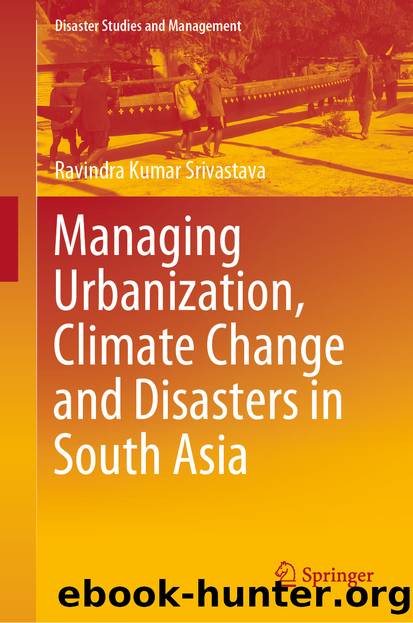Managing Urbanization, Climate Change and Disasters in South Asia by Ravindra Kumar Srivastava

Author:Ravindra Kumar Srivastava
Language: eng
Format: epub
ISBN: 9789811524103
Publisher: Springer Singapore
5.3 Built Ups in the Flood Basin
River basins are changing across the world due to anthropogenic pressures like urbanization, industrialization and population growth. Urbanization leads to land-use changes, degradation of the water quality of rivers, increased flooding and disorders in the natural river basin ecology. Flooding disasters in megacities like Mumbai (2005) and Delhi (2010) was lessons showing that the encroachment of a natural drainage system for developmental purposes would result in a threat to the urban life. The preservation of river basin ecosystem would require better planning and regular monitoring of human activities around it. Compilation of facts related to river basin with available erudite tools and techniques as well as preparation of integrated river basin management plan may help as a control strategy to reduce degradation of urban river basins [47].
The cities created on the riverside in different basin are now in stress. As the globe continues to warm, more water-induced disasters are expected especially in the Himalayan region, where very little is studied as to how the global warming would affect the climate and hydrological processes. The cities and the river had a close relationship from time immemorial. They evolved and developed into great political, cultural, religious and economic centres by the sides of river as a result of easy access to water supplies and navigation and also for defence. Whether in Asia or in Europe, great cities such as Patliputra, Varanasi, Kolkata are located on the banks of river Ganges in India, Paris is located on the River Saine, London on River Thames and many such historical cities are located on the banks of major rivers of that country. These centres on the bank of river, however, have suffered the wrath of flood from time to time which arises due to regional floods on major rivers, the floods caused by melting of snow, local river overflow or flooding on small urbanized street on account of choking of the natural drainage system by the settlements in these areas.
Indian subcontinent has long exchequered history of urbanization in the early period of known civilization and their collapse [14]. With the gradual advent of warmer and wetter conditions since the current geological period known as Holocene (10,000–7000 yrs bc), the Indus river saw its flow in full strength and gave rise to the growth of Harappa and Mohanjo-daro’s urban civilization on the north and south of the stream. The cities along the bank of Indus River, however, are estimated to show signs of decline since 1800 bc, due to possible climate change besides tectonic events having perhaps redirected the rivers in Punjab. The study of the impact of climate change in the different river basins are thus important to understand the development of the mitigation strategy to address the challenges posed by the growing urbanization in this region. The urban setups in SAR’s river basin is given in Table 5.9.Table 5.9SAR cities located on major river banks
Download
This site does not store any files on its server. We only index and link to content provided by other sites. Please contact the content providers to delete copyright contents if any and email us, we'll remove relevant links or contents immediately.
International Integration of the Brazilian Economy by Elias C. Grivoyannis(75823)
The Radium Girls by Kate Moore(11639)
Turbulence by E. J. Noyes(7720)
Nudge - Improving Decisions about Health, Wealth, and Happiness by Thaler Sunstein(7262)
The Black Swan by Nassim Nicholas Taleb(6786)
Rich Dad Poor Dad by Robert T. Kiyosaki(6196)
Pioneering Portfolio Management by David F. Swensen(6092)
Man-made Catastrophes and Risk Information Concealment by Dmitry Chernov & Didier Sornette(5673)
Zero to One by Peter Thiel(5507)
Secrecy World by Jake Bernstein(4406)
Millionaire: The Philanderer, Gambler, and Duelist Who Invented Modern Finance by Janet Gleeson(4117)
The Age of Surveillance Capitalism by Shoshana Zuboff(4001)
Skin in the Game by Nassim Nicholas Taleb(3980)
The Money Culture by Michael Lewis(3859)
Bullshit Jobs by David Graeber(3851)
Skin in the Game: Hidden Asymmetries in Daily Life by Nassim Nicholas Taleb(3738)
The Dhandho Investor by Mohnish Pabrai(3574)
The Wisdom of Finance by Mihir Desai(3539)
Blockchain Basics by Daniel Drescher(3343)
